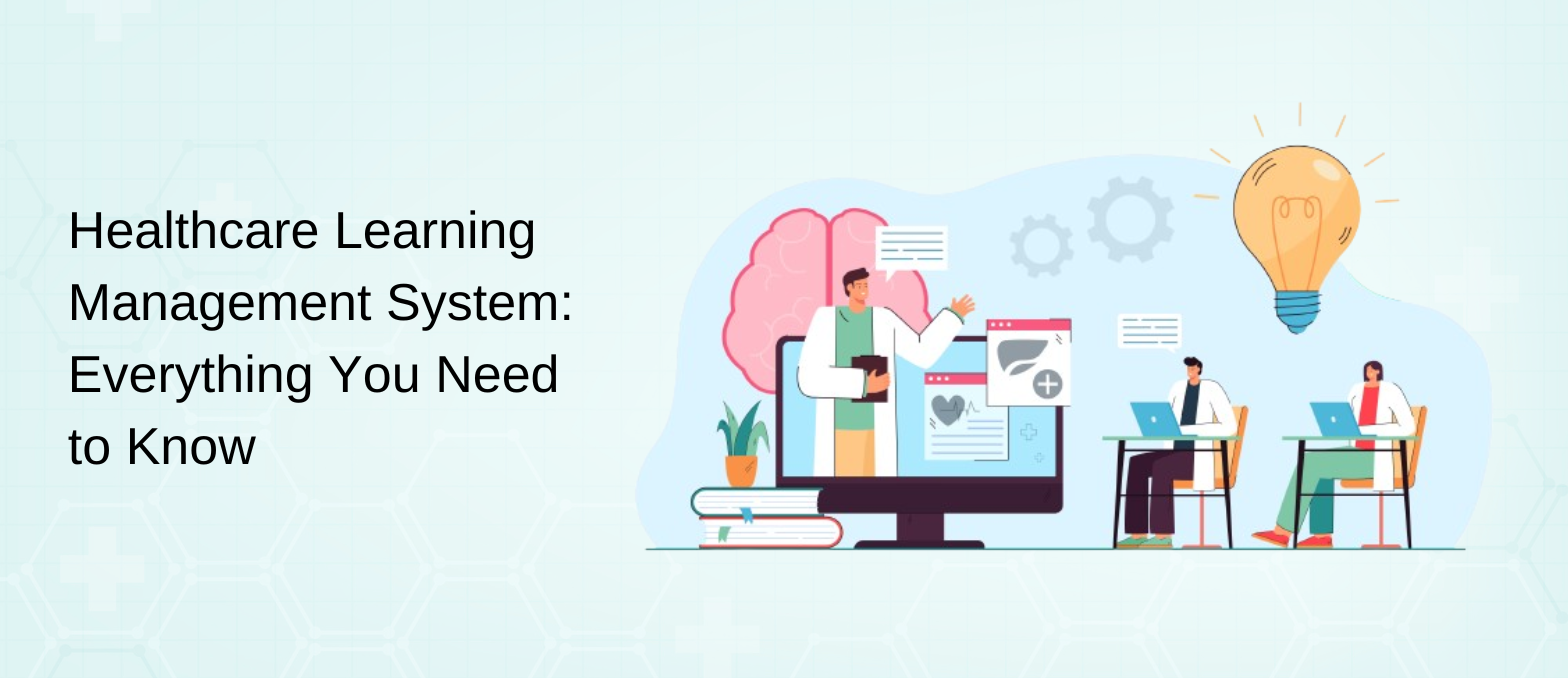Natural language processing technology (NLP) makes digital transformation easier. Natural language processing (NLP) enhances financial outcomes, automates tasks, and provides profitable insights for businesses.
The end of 2025 is projected to see the global NLP market generate over $43 billion in revenue, reflecting a significant increase from $24 billion in 2022. Furthermore, the pattern demonstrates how businesses in a variety of industries are increasingly utilizing NLP-based technology.
Brief Overview of NLP Solutions
A typical data warehouse contains every type of data, ranging from daily or seasonal trends to on-site observed client behavior. Moreover, businesses have gained new insights into understanding their customers, thanks to the information provided. 80% of the data produced is unstructured. It comes via interactions on social networking platforms, in talks with customer support agents, and in other contexts. Furthermore, to gain insight from the vast amounts of unstructured data that are available online and in call logs, generative AI development companies are turning to NLP technologies.
Natural language processing solutions, to put it briefly, allow machines to read, comprehend, and interpret human languages. The difficulty with NLP vs. LLM here is that individuals must explicitly use highly structured programming languages to communicate with computers, natural language is everything but explicit.
Machines have never been able to fully understand the context of human language because of highly organized languages. Computers can now identify the uncertainty in human language, however, thanks to machine learning solutions.
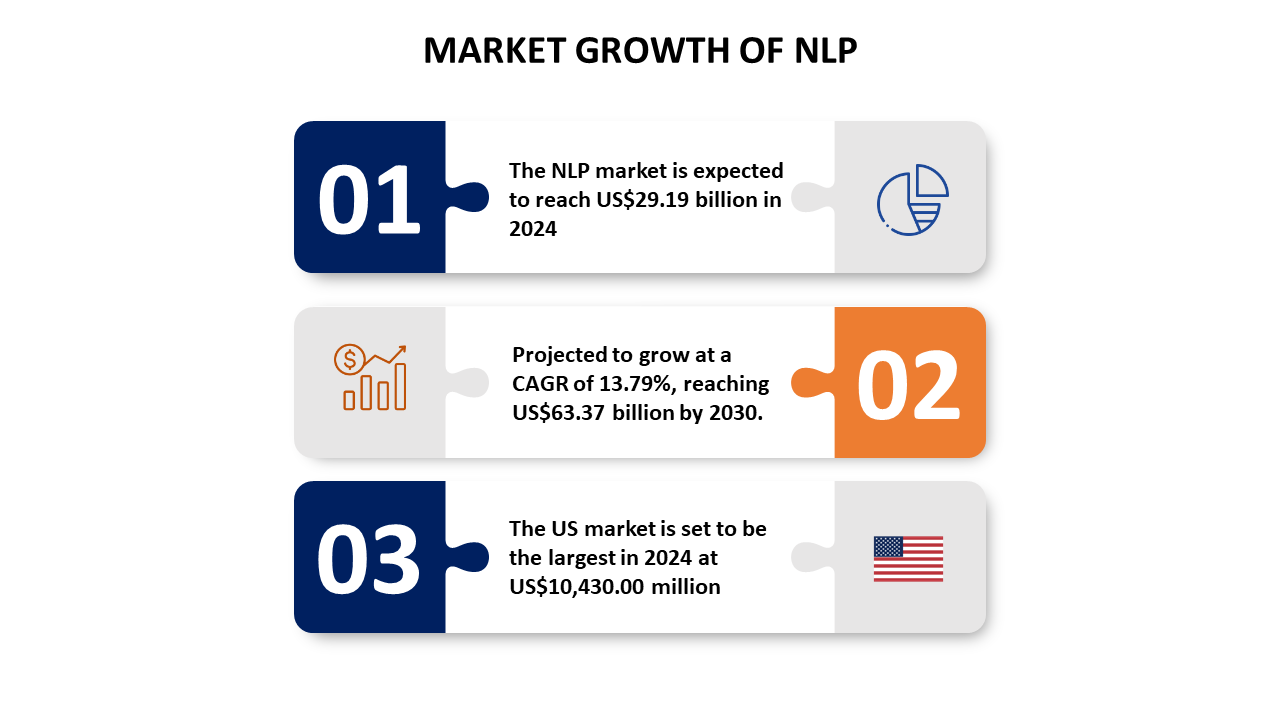
The Power of Natural Language Processing
The most well-known natural language processing tool is GPT-3 from OpenAI. NLP practitioners refer to such NLP tools, as “language models,” for performing both basic analytics activities such as answering queries and summarizing reports. As well as more complex tasks like document classification and sentiment analysis in text blocks.
Humans have adjusted to the most recent version, InstructGPT, to produce replies that are far more in line with user intents and human values. Additionally, Google’s most recent model Gemini demonstrates even more remarkable advancements in language and reasoning.
Writing, coding, and discipline-specific thinking are the three areas where GPT-3 has shown the greatest promise for artificial intelligence development companies. OpenAI, the Microsoft-funded company that created GPT-3, has created a GPT-3-based language model to assist programmers by producing code from natural language input.
By entering instructions, Codex may create a rudimentary video game. It is already the engine behind products like Copilot for Microsoft’s subsidiary GitHub. Although there was anticipation that this revolutionary potential would alter the nature of programmers’ work. The improvement of models is still ongoing. For instance, the most recent model from Google’s DeepMind AI lab shows the critical thinking and logical abilities required to outperform the majority of humans in programming competitions.
Foundation models, which also function with other kinds of data like photos and video, are models like GPT-3, which are part of an emerging field of AI research. It is possible to train foundation models on multiple types of data simultaneously. OpenAI’s DALL·E 2, for example, has undergone training in both language and image data, enabling it to generate high-resolution renderings of settings using just text cues.
Economists anticipate that foundation models will have an impact on all sectors of the economy and potentially spur economic growth comparable to that of the Industrial Revolution because of their capacity to change the nature of cognitive labor.
The Business Benefits of NLP Technology
-
Provide quick client support
If you’ve never heard of natural language processing (NLP), you’ve probably heard of chatbots. AI-based computers that can communicate with users on websites or in applications. Furthermore, chatbots for NLP (natural language processing) can respond quickly to customers’ questions, day or night.
Because chatbots act as customer service automation executives, they can utilize predetermined responses to queries that center around the same themes, saving clients from having to wait for a service response. Furthermore, they can offer specialized assistance such as forwarding a link to instructions, scheduling a service, or locating specific products.
The options are virtually limitless; everything hinges on the company’s business requirements in question. Furthermore, chatbots are now able to discern a user’s intention because of developments in machine learning techniques and word analysis.
Chatbots are the ideal answer in a time when instant gratification is demanded. Furthermore, they’ll even turn potential clients into paying customers by providing incredibly attentive service; if a guest runs into an issue, swiftly resolve it to keep them from going to a rival.
You can see that automated customer support has a lot of advantages. Additionally, a study by Opus predicts that by 2021, businesses will spend up to $4.5 billion on chatbots.
2. Conserve resources and time
A profit is a must for any firm. Additionally, producing money is much easier if you can figure out how to save. NLP provides a tried-and-true method for companies in a variety of industries to reduce costs and time.
Let’s examine chatbots as an example.
As per Chatbots Magazine, the NLP implementation of automated help can result in a 30% reduction in customer care expenses. By freeing up staff time, NLP-based solutions enable you and your team to concentrate on innovative projects that engage customers and increase revenue.
Let’s say that for a product you recently published, there are now no responses in your database. You’ll eventually be able to expand the amount of responses your chatbot can deliver using the same model when users ask queries.
Other applications of NLP-based solutions, such as a system for controlling comments on a website, fall into a similar category.
A model should be able to assess new phrases. If it is to remain as successful as possible people may occasionally introduce new words, which are typically some sort of online slang.
3. Manage the content consumers create
Let’s move past chatbots and examine an alternative NLP-based remedy. Furthermore, technology can be used to impose spam filters and prohibit undesirable content from appearing in emails and on websites. Let’s say you run a blog with a high comment count or a news service.
The purpose of NLP solutions is not limited to identifying “forbidden” terms or vulgarisms. They also help you moderate user-generated content that readers publish on your forum, allowing you to preserve its integrity without provoking controversy, unsolicited advertising, or backlinks to harmful websites.
A model might label anything as hate speech even if it doesn’t contain any objectionable language. How is it possible? If given enough data, advanced NLP models can learn to understand sentence context and assign a sentence to the correct category.
Additionally, the model can decipher a user’s emotions by examining the emoticons they use when the right tokens are used. Because user language varies greatly throughout websites, you can even customize the solution for a certain target or location.
4. Increase the conversion rate
For many marketing directors, the primary goal is to convert website visitors into customers. And better the conversion rate, the cheaper the client acquisition cost, and companies employ a variety of techniques to maximize it.
Conversion optimization is something that NLP solutions excel at. Furthermore, our beloved chatbots are among the offerings, along with more sophisticated search capabilities and basic-looking services like auto-complete text.
The idea behind it all is straightforward. Everything you can do to get people to stay on your website will probably increase their likelihood of purchasing or using your services.
5. Boost the experience for the end user
There is a common element throughout points one through four: they all enhance the end-user experience. In other words, your website visitors can: because of NLP
- Use semantic search engines to quickly locate what they’re seeking.
- Use (you guessed it) chatbots to get assistance instantly.
- See only content of the highest caliber; stay away from hate speech and spam by employing user-generated content (UGC) moderation techniques.
A positive user experience is critical to your company’s success. Whether or not a user will suggest your services to their network depends on all of the previously mentioned factors.
6. Raise satisfaction among staff members
When it comes to NLP-based software, these duties include: AI-based solutions are designed to tackle the most tedious, repetitive, or time-consuming tasks.
- responding to the same queries
- controlling remarks
- serving as a customer service representative
- keeping an eye out on social media for mentions of a business, its goods, or services
- Searching and filtering documents (like resumes) for keywords
- Sorting emails (spam, for instance)
- Grammar checkers, among many others.
You can hire an AI developer to automate the jobs if there are any items that your team would want to avoid. Furthermore, you’ll not just bring happiness to your staff. You’ll assist them in being more productive and free up time for them to pursue their passions.
As a result, you’ll witness a sharp increase in worker happiness and job engagement, as well as positive effects on hiring and retention from your employer brand.
7. Have a better search ranking
One important aspect of the company is search engine optimization. Furthermore, every business aspires to rank as highly as possible. You guessed it: Natural Language Processing has certain advantages.
To optimize your content and save time on research, solutions can analyze search queries. They can also identify and suggest similar keywords. This will boost the SEO of your website and increase the visibility of your business.
You’ll also be able to develop campaigns that are more narrowly targeted and better target customers.
Integrate NLP Into Your Business and Unlock the Power of Text Data
NLP Solutions in Different Industry Verticals
NLP solutions are being applied in many different industry verticals, transforming corporate operations, raising customer satisfaction levels, and promoting innovation. Furthermore, here’s an illustration of how NLP is impacting several industries:
1. Healthcare/Clinical Documentation:
Natural Language Processing works on the exactness of documentation. It saves healthcare laborers’ time via robotizing the extraction of basic data from clinical records.
– Patient Interaction: Requests, arrangement booking, and wellbeing-related material are undeniably taken care of by chatbots outfitted with natural language processing (NLP) abilities, all of which work on absolute patient commitment.
2. Finance/Sentiment Analysis:
NLP processes financial news and social media to monitor market sentiments, assisting traders and investors in making wise choices.
– Client support: Moreover, financial institutions operate more efficiently when virtual assistants with NLP skills manage client inquiries, transaction monitoring, and fraud detection.
3. Retail/Personalized buying:
NLP examines the tastes and actions of the consumer to provide tailored product recommendations, improving the whole buying encounter.
-Inventory Management: Natural language processing (NLP) enhances stock levels, brings down costs, and concentrates information from unstructured information to assist with inventory examination and management.
4. Client administration/Chatbots:
By utilizing NLP, chatbots may rapidly and precisely answer buyer questions, expanding consumer loyalty and easing up the responsibility for helping staff.
– Sentiment Analysis: Using reviews and feedback, NLP helps businesses ascertain the sentiment of their clients, enabling more proactive customer service and answers.
5. Legal/Contract Analysis:
NLP reduces the possibility of error and saves time by automating the process of analyzing legal documents and extracting relevant information and key terms.
– Legal Research: NLP improves the efficiency of legal practitioners by expeditiously digesting and summarizing large volumes of legal materials.
6. Education:
Natural Language Processing (NLP) enables personalized and interactive language learning experiences, including pronunciation correction and contextual comprehension.
– Automated Grading: NLP uses automated grading to provide prompt, accurate feedback on written assignments to educators and students.
7. Human Resources/Resume Screening:
NLP extracts pertinent information from resumes and matches candidate abilities with job criteria, which helps HR teams go through resumes quickly.
– Employee Feedback: By analyzing employee feedback and surveys, NLP offers insightful information that may be used to enhance workplace satisfaction and culture.
8. Telecoms/Customer Engagement:
By facilitating automatic responses, problem-solving, and tailored communication, NLP improves customer service in the telecom industry.
– Network Monitoring: To enhance overall network performance and efficiency, NLP processes and analyzes data connected to the network to perform predictive maintenance.
NLP is still developing, providing customized solutions to specific problems in each business, proving its adaptability and potential for good change in a wide range of fields.
Gain Valuable Insights By Automating Text Processing
NLP Tools and Techniques
To study and understand human language, NLP is a sophisticated field that uses a variety of methodologies. Furthermore, these methods cover everything from basic text preprocessing to sophisticated machine learning algorithms. We will now examine the primary natural language processing (NLP) methods frequently employed in text analysis and NLP.
1. The process of tokenization
The process of tokenization entails dividing the raw text into smaller pieces known as tokens. Moreover, to help data scientists build an NLP model, these tokens—which might be words, phrases, or sentences—help them comprehend the context.
Tokenization transforms unstructured data into a machine-learning-ready numerical structure. Furthermore, computers can now comprehend and evaluate the text’s meaning thanks to this.
Word, character, and sub-word tokenization are among the several forms of tokenization.
For instance, if word tokenization were used to tokenize the line “Where is the library?” the output would be [‘Where,’ ‘is,’ ‘the,’ ‘library,’ ‘?’].
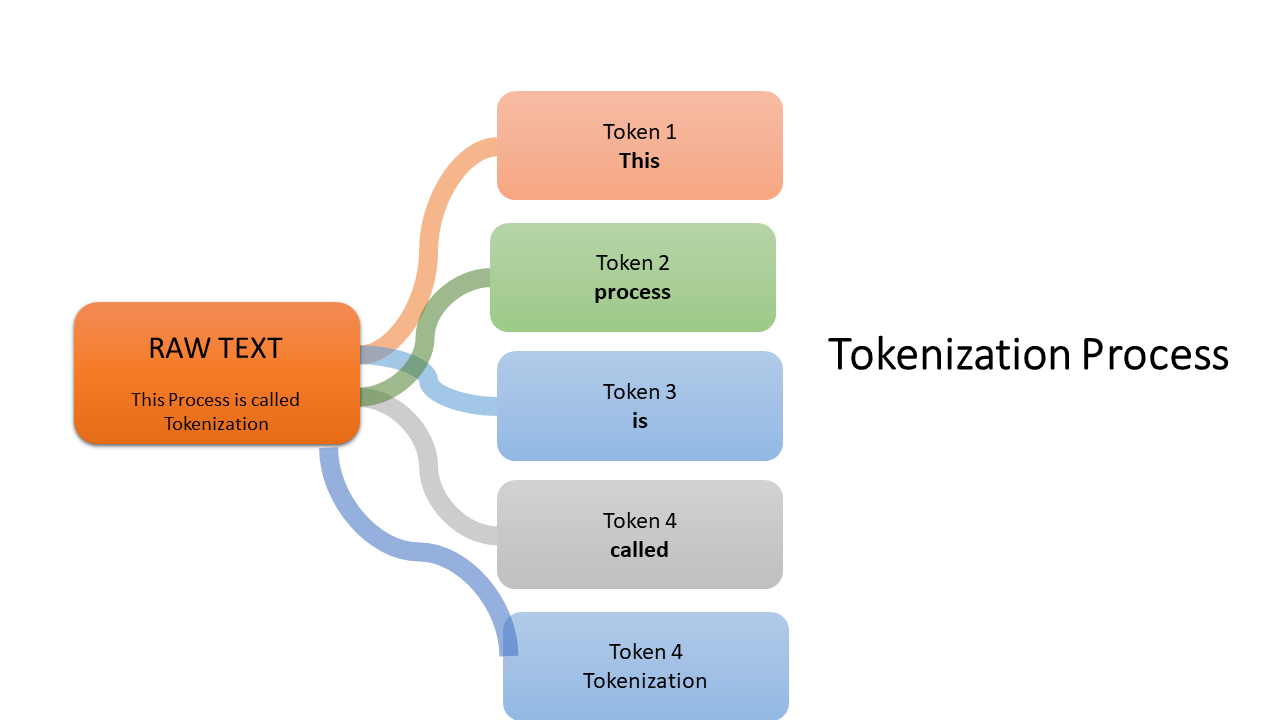
2. Stemming and lemmatization
Using stemming and lemmatization, words can be reduced to their base or root forms. Furthermore, by removing affixes from a word, the stemming process can produce a base word that may or may not be accurate. Whereas, using morphological analysis and vocabulary, lemmatization is a more advanced natural language processing technique that yields the correct base form, or lemma.
For instance,
To improve the accuracy and effectiveness of NLP models, both strategies are essential for de-noising data and simplifying text. Thus, stemming and lemmatization aid in enhancing text analysis, search query performance, and computer comprehension of language.
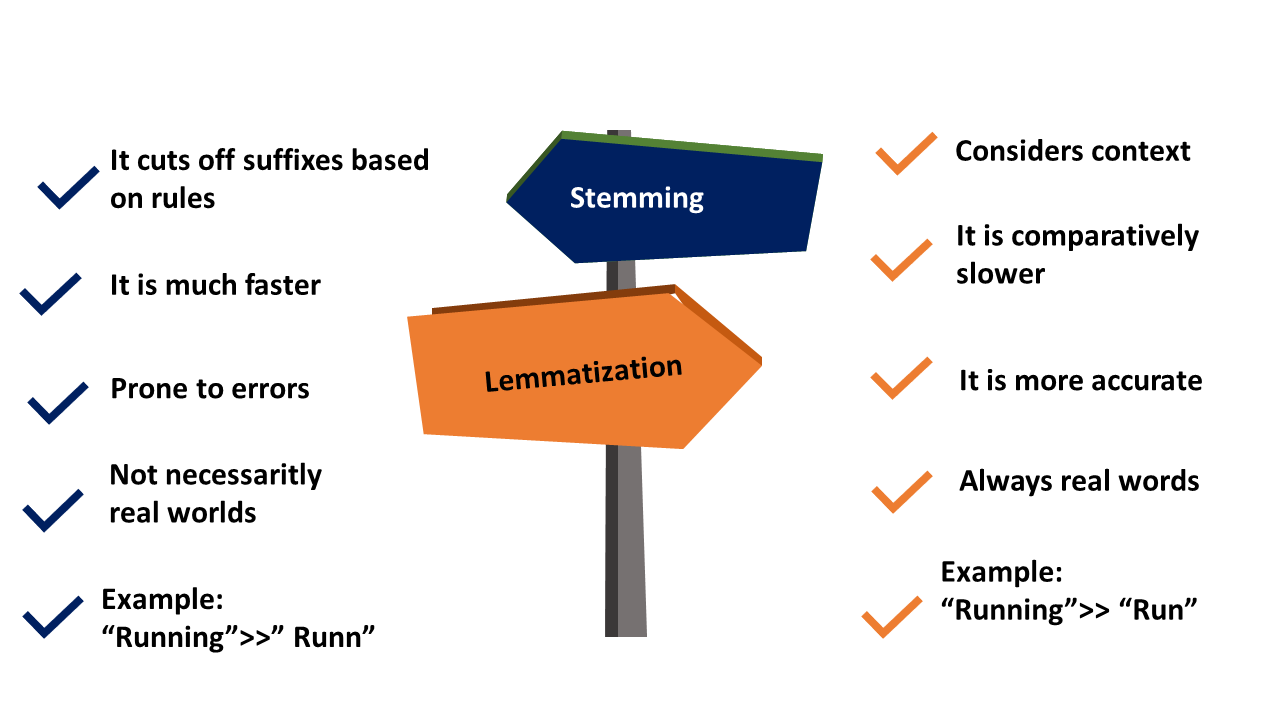
3. Quit deleting words/Stop Word Removal
Common words with little significance, such as “and,” “in,” “the,” and “is,” are known as stop words. They can introduce noise into data. NLP techniques can perform much better when these stop words are eliminated from the text, particularly when text classification tasks are involved. It is a crucial preprocessing step since it lowers the dimensionality of the data and boosts the models’ effectiveness.
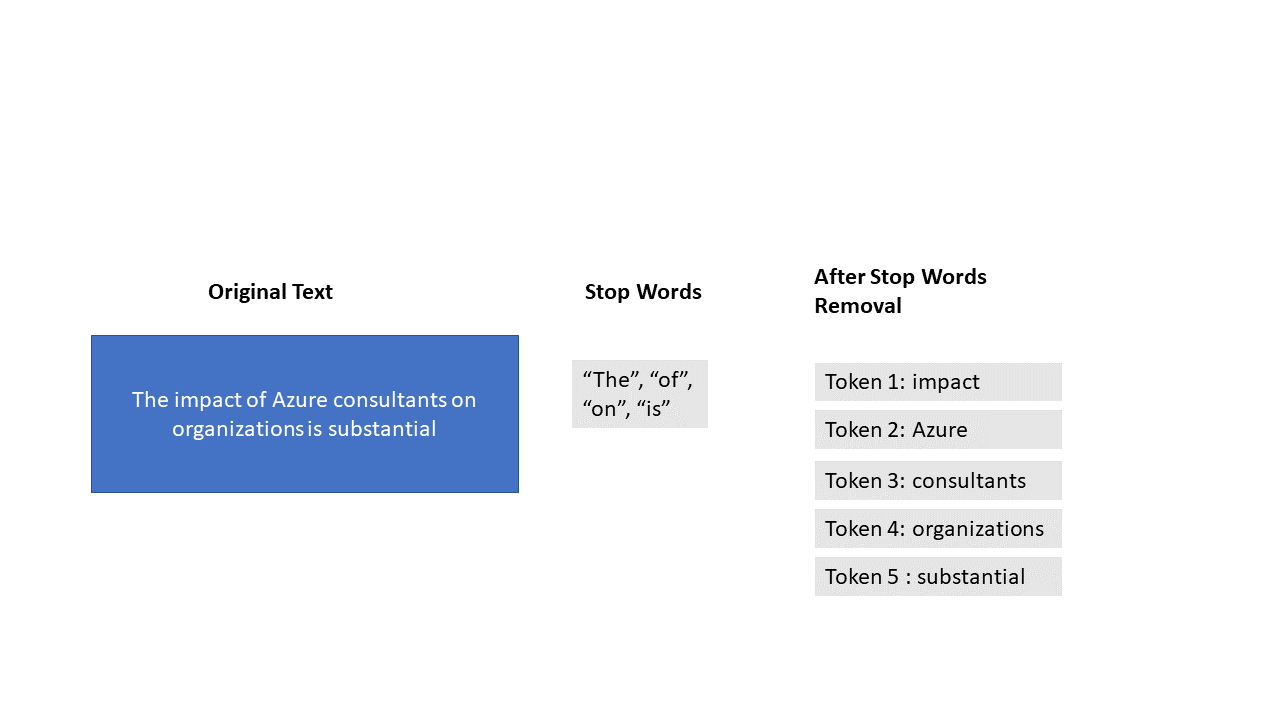
4. Text categorization
Text classification, sometimes referred to as document classification, is the process of grouping text according to its content into pre-established classes or categories. Furthermore, this method is extensively employed in many different applications, including topic recognition, Sentiment analysis technology, and spam filtering.
Popular text categorization techniques include Naive Bayes, Support Vector Machines (SVM), and models based on deep learning such as Recurrent Neural Networks (RNN) and Convolutional Neural Networks (CNN).
5. Analysis of sentiment
Sentiment analysis, emotion artificial intelligence, or opinion mining is the technique of locating and removing subjective information from text data, such as attitudes, views, and feelings. Furthermore, brand loyalty measurement and customer experience analytics are two areas in which this NLP technique finds use.
Sentiment analysis examines textual data from social media posts, consumer evaluations, and other sources to help with decision-making and performance enhancement. For instance, can be used by a movie streaming service to rank user evaluations as extremely positive, very negative, neutral, positive, or neutral.
Moreover, by customizing its content recommendations with this data, the platform can increase user pleasure and engagement. All things considered, sentiment research is essential for improving company strategy and consumer experiences.
Sentiment analysis comes in several forms: aspect-based analysis, emotion detection, and graded sentiment analysis.
6. Topic modeling
Unsupervised and highly effective, topic modeling organizes words and phrases into groups to find underlying themes without requiring training data or tags. Furthermore, large volumes of text can be summarised more easily, which saves time and resources.
Moreover, topic modeling offers more context and a deeper understanding by identifying highly related words that group together.
For example, topic modeling can identify five major topics present in the data, reducing the processing from 500,000 threads to just 2,500 threads in a corpus of 1000 papers with 500 words each. This effective method not only resolves difficult issues but also improves text comprehension and visualization.
7. Text summarization
Text summarizing refers to the process of extracting the most crucial information from a lengthy text and reducing it to a more concise, logical summary. Furthermore, there are two primary methods for summarizing texts:
- Extraction: the process of removing key phrases to form a summary from the source material
- Abstraction: A process of analyzing a text semantically to produce a summary that may or may not include terms from the source text.
Applications for text summarization include news aggregation, and information extraction, and content analysis.
8. Recognizing Named Entities
Utilizing pre-laid out classifications, Named Element Acknowledgment (NER) finds and categorizes named entities inside a record. These classes comprise individuals, gatherings, times, places, and monetary sums. With this sort of natural language processing (NLP) technology, organizations can observe between unstructured data and vital structured data.
This information can then be utilized for knowledge management, data mining, and information retrieval, among other uses.
Take this sentence, for example:
- One type of NER system is dictionary-based, which requires regular dictionary updates. It recognizes entities using string-matching techniques and a predetermined vocabulary.
- Depending on word morphology and context, rule-based systems exploit pattern-based and context-based rules to extract information.
- To overcome the drawbacks of the previous two methods, machine learning-based systems employ statistical models and feature-based representations to identify entity names.
- Deep learning techniques reduce feature engineering work and enable complicated relationship learning by mapping input data to non-linear representations.
How Does the Future of Business Will Look WIth NLP Services?
The previous ten years have seen significant advancements in natural language processing or NLP. Initially, a specialized field of study centered on elementary text analysis, artificial intelligence (AI) has developed into a broad range of methods for producing and comprehending text, as well as enabling bidirectional communication between systems and people.
Natural language processing (NLP) will have a revolutionary effect on business in the next two to five years, predicts Gartner’s most recent Hype Cycle for Natural Language Technologies. Understanding these advancements and how NLP might benefit your company is essential for CIOs. There are three main areas to pay attention to:
-
NLP Makes Human-Computer Interaction Smooth
NLP is the engine of conversational AI such as chatbots and virtual assistants, which can comprehend questions posed in text or voice, provide intelligent answers, and even have bidirectional conversations. Neural network technology is always improving, making these systems more and more lifelike.
Conversational AI technology can help your company increase efficiency and cut expenses by automating simple but repetitive operations like IT support tickets, HR questions, and customer service. Workers can now concentrate on more important tasks. Anticipate increasingly sophisticated interactions and workflows handled by AI assistants over the next two to five years.
KEY TAKEAWAY: Assess how conversational AI experts may enhance customer and staff experiences and efficiency by automating tasks and facilitating smooth interactions.
-
Unstructured Text Data Can Be Valuably Extracted By NLP
There are probably vast amounts of unstructured text data in your company that are dispersed throughout knowledge bases, papers, customer chats, surveys, and other sources. NLP can mine this unexplored data for embedded insights by:
- Sentiment analysis to measure emotional state, pinpoint problems, and track perception of a brand
- Entity recognition for the identification of individuals, locations, groups, and ideas
- Topic modeling to identify important themes and patterns in various corporations
- Summarizing documents to extract important details and ideas
These competencies support the development of data-driven strategy, operations, and decision-making. NLP will get better at interpreting complex ideas and semantics from text over the next two to five years.
KEY TAKEAWAY: Your organization can acquire significant insights from its unstructured data by using natural language processing (NLP) methods like opinion examination and theme modeling.
-
Document-Centric Procedures Are Automated by NLP
Documents such as emails, reports, support tickets, contracts, and more are crucial to many corporate operations. NLP can automate workflows that are currently document-based by
- Documents are categorized by kind to ensure proper routing.
- critical data items must be extracted for operations
- Use templates to create documents, including filling out forms or customizing correspondence
- responding to inquiries regarding the contents of the paper
This increases efficiency by removing the need for workers to handle documents by hand. Expect NLP document processing to improve in speed and accuracy over the next two to five years.
KEY TAKEAWAY: Find procedures that include a lot of documents and that NLP approaches can be used to automate or augment.
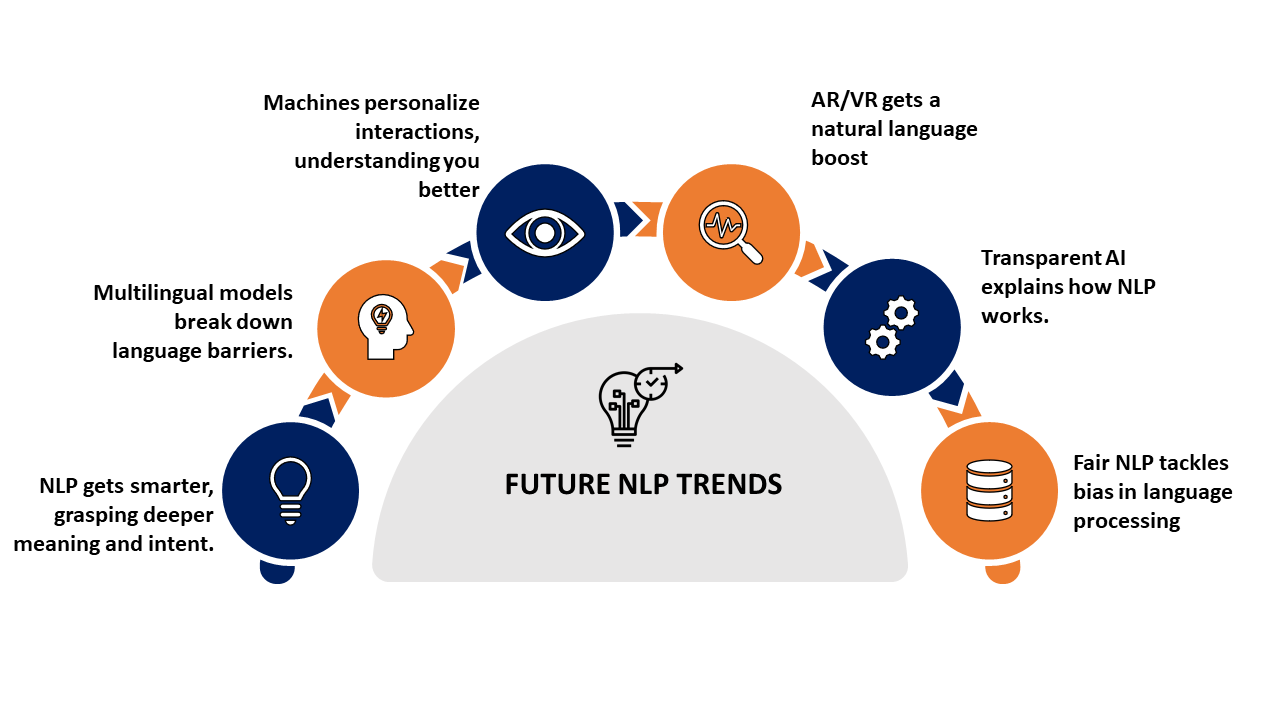
Transform Insights into Actions With Natural Language Processing Services with A3Logics
Leading the way in bringing about revolutionary change via the skillful application of Natural Language Processing (NLP) services is A3Logics, top artificial intelligence solutions company. Our use of cutting-edge NLP technologies, which unlock the actual potential of data and language across varied applications, demonstrates our steadfast dedication to innovation.
Our approach involves utilizing natural language processing (NLP) to extract significant insights from intricate datasets, emphasizing sophisticated data interpretation. This allows businesses to obtain actionable intelligence from unstructured data.
Effortless Service Board
Our NLP-driven solutions enable systems to comprehend and respond to user queries, facilitating seamless communication between humans and machines and improving overall consumer experiences and interactions. From task automation to document analysis, A3Logics helps businesses achieve unparalleled efficiency by integrating natural language processing (NLP) into smart automation processes.
- Our dedication also includes proactive decision-making, where we convert unprocessed data into useful insights that provide decision-makers with a thorough grasp of patterns, trends, and sentiments.
- We customize NLP services to satisfy the needs of various businesses, like medical services, banking, and retail, to help client commitment, functional proficiency, and compliance.
- By involving chatbots and sentiment analysis to connect with purchasers in a convenient and customized manner, A3Logics further develops client encounters and increments consumer loyalty and reliability.
Furthermore, by utilizing NLP for risk reduction and compliance monitoring, we help businesses comply with regulations and maintain industry standards.
A3Logics puts its clients in a successful position in the rapidly shifting digital market by being on the cutting edge of NLP breakthroughs and consistently innovating to address changing business needs.
In a time when actionable intelligence is essential for long-term success, our NLP services represent a dedication to turning insights into concrete actions. By acting as a necessary link between data and results, we enable enterprises to flourish.
Conclusion
Finally, it should be noted that Natural Language Processing (NLP) solutions are a game-changer for businesses, providing unmatched chances for expansion and productivity. NLP technologies have shown to be invaluable resources as companies increasingly realize the need to comprehend and utilize human language data.
NLP has an indisputable positive effect on corporate success, from improving customer interactions to optimizing internal operations. Further NLP development offers even more creativity and prosperity for companies ready to adopt and use these potent solutions in the future.
FAQ
1. In what ways may NLP solutions raise customer happiness and engagement?
Through the use of NLP technology, businesses may more efficiently evaluate and comprehend client requests, attitudes, and comments. Businesses may boost customer engagement and ultimately increase satisfaction and loyalty by automating responses and offering individualized interactions.
2. How might NLP help a company streamline its internal operations?
Among the tasks and projects that NLP enhances are data extraction, document summarization, and information categorization.
By making simpler internal processes, reducing manual labor, and freeing up staff time for more strategic and value-added work, it increases overall operational efficiency.
3. How may competitive intelligence and market research benefit from NLP?
Through the analysis of massive volumes of unstructured data, including reviews, industry reports, and social media, NLP assists organizations in gaining insightful knowledge. Gaining a competitive advantage and facilitating well-informed decision-making, helps in comprehending market trends, consumer preferences, and rivals’ plans.
4. How might NLP technologies improve hiring and HR procedures?
NLP helps expedite the hiring process;
- By identifying important talents,
- automating resume screening, and
- even using language analysis to determine a candidate’s cultural fit, .
This guarantees a more accurate candidate selection process, speeds up the hiring process, and helps to create a team that works well together.
5. What role do risk management and fraud detection play for NLP solutions?
NLP is essential for finding patterns and abnormalities in textual data, which enables firms to spot fraud and effectively manage risks. Through the analysis of communication data and transactional information, natural language processing (NLP) can enable proactive risk mitigation strategies and offer early warnings.
6. What obstacles do companies encounter when putting NLP solutions into practice, and how can they get past them?
Problems with implementing NLP solutions could include integration complexity, data protection issues, and the requirement for specialist knowledge. Businesses can overcome these obstacles by making data security a top priority, putting money into team training, and working with seasoned AI solution providers to guarantee a successful deployment.



![How to Make Health & Fitness Apps Like Fitbit? [2024 Guide]](https://www.a3logics.com/wp-content/uploads/2024/04/How-to-Make-Health-Fitness-Apps-Like-Fitbit.webp)






